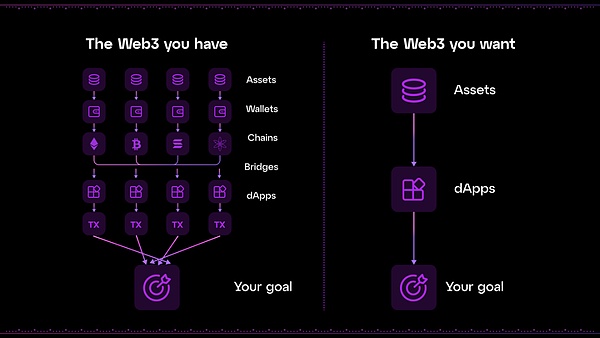1. User demands
Ordinary users have only one demand for Web3 wallets: whether it can make their on-chain surfing more convenient.
Wallets are the entrance to the Web3 world and are high-frequency applications used by every ordinary user every day, so convenience is very important and cannot be overemphasized. (Of course, security is the bottom line)
However, most wallets are not doing well enough now. Ordinary users need to understand many concepts before they can really use them, such as understanding private keys, understanding Gas, understanding cross-chain, etc.
Although many wallets have smoothed the differences between different chains as much as possible at the application layer and tried to provide users with a unified experience, a typical example is the OKX wallet, which aggregates a lot of chains, DEX and cross-chain bridges, and can complete these operations in one stop.
However, this does not fundamentally solve the problem, and users still need to understand various concepts based on the characteristics of blockchain.
2. Chain abstract narrative
There is a bold and radical way: that is to completely overturn the current user experience and change the user interaction mode that seems to have become an "industry paradigm".
The complexity of the current wallet lies in the concept of "chain". There are too many chains now, and more encapsulation should be done at the product level, so as to provide a completely different product experience.
In this scenario, you can consider combining "chain abstraction", that is, encapsulating the concept of chain, so that users do not need to perceive the concept of chain, the existence of Gas token, chain cutting and cross-chain, and use a universal token to pay the handling fees of all chains.
This is the common experience of Web2 applications that truly meets the needs of novice users.
The current benchmark product in the chain abstraction track is: UniversalX.
UniversalX allows us to see what chain abstraction applications really look like, rather than staying at the conceptual stage. It is worth learning for project parties in the Web3 wallet track.
3. Changes in wallet paradigm
Chain encapsulation is a major trend. Because of the explosion in the number of chains, the learning cost for ordinary users is too high, so the complexity of the chain should be left to the application itself, which is also the source of the "chain abstraction" narrative.
Existing wallets are also doing chain encapsulation at the application layer, but they are not thorough, or they have not yet realized the value of chain abstraction more deeply.
Chain abstraction actually fundamentally reshapes the paradigm of existing wallets, from "multi-chain wallets" to "chainless wallets".
That is, from the simple aggregation of multiple chains to the underlying encapsulation of multiple chains, users no longer perceive the existence of multiple chains.
It should be noted that the impact of this technological innovation is slow. Only after the first to eat crabs have achieved certain results can they attract other people to pay attention to this technology, but the first-mover advantage will be gone.
Currently, the Web3 wallet track is in fierce competition, among which OKX wallet is leading the way. If other competitors want to overtake on the curve, they need to try more innovative ways and make different things, so as to form a differentiated competitive advantage.
Among them, chain abstraction is one of the technological changes worthy of attention of Web3 wallets.
The pattern of the wallet track is not yet determined. Only when the experience is good enough and only when the user needs are truly met, can the product develop in the long run and occupy a place in the Web3 entrance traffic war.

 JinseFinance
JinseFinance
 JinseFinance
JinseFinance JinseFinance
JinseFinance JinseFinance
JinseFinance JinseFinance
JinseFinance JinseFinance
JinseFinance JinseFinance
JinseFinance JinseFinance
JinseFinance JinseFinance
JinseFinance JinseFinance
JinseFinance JinseFinance
JinseFinance